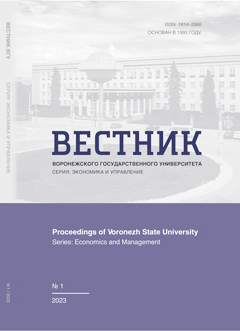Оценка влияния масштабов национальных фондовых рынков и различных кризисных явлений в экономике на уровень рисков операций с финансовыми инструментами
Аннотация
Предмет. В академической дискуссии, посвященной особенностям финансовых кризисов центральное место занимает анализ исторических паттернов волатильности. Большинство исследователей указывают на то, что для финансовых кризисов характерны продолжительные по времени сильные флуктуации на фондовых рынках. Подобная реакция на кризисные явления в экономике наблюдается на протяжении известной финансовой истории. Поиск движущих сил, стимулирующих именно такое поведение, вызывает интерес как в академических кругах, так и у участников фондовых рынков.
Цель. Изучение влияния масштабов национальных фондовых рынков и различных кризисных явлений в экономике на уровень рисков операций с финансовыми инструментами.
Методология. Идентификация скрытых режимов проводилась с использованием моделей с Марковскими переключениями. В основу определения скрытых рыночных состояний положено соотношение компонент финансовой турбулентности, характеризующих изолированные изменения корреляционного риска и волатильности. Оценка влияния масштаба фондовых рынков на показатели доходности и риска операций с финансовыми инструментами производилась с помощью модели векторной авторегрессии.
Результаты. Оценка влияния кризисных явлений в экономике на числовые характеристики избыточной доходности крупнейших мировых фондовых рынков с использованием двухрежимных моделей с Марковскими переключениями выявила значимые различия в поведении фондовых рынков на различных отрезках времени. В работе установлено, что в периоды, сопровождающиеся кризисными явлениями в экономике, доминирующим на рынке режимом является режим высокой волатильности. Комбинируя типичные и атипичные значения компонент финансовой турбулентности, выявлены четыре скрытых состояния рынка, которые предоставляют дополнительную информацию о грядущем изменении или сохранении действующего на рынке режима. Для рынков с высокой капитализацией характерны односторонние каузальные связи. Приспособление рынков к шокам рынка США происходит почти вдвое медленнее, чем к шокам развивающихся рынков.
Выводы. Выявленные зависимости позволяют повысить объяснительный и прогностический потенциал статистического анализа рисков на национальных фондовых рынках.
Metrics
Литература
Aimer, N. M., & Lusta, A. A. (2021). Exchange rates and oil price under uncertainty and regime switching: A Markov-switching VAR approach. Economic Journal of Emerging Markets, 13(2), 200–215. https://doi.org/10.20885/ejem.vol13.iss2.art9
Alemany, N., Aragó, V., & Salvador, E. (2020). Lead-lag relationship between spot and futures stock indexes: Intraday data and regime-switching models. International Review of Economics and Finance, 68, 269–280. https://doi.org/10.1016/j.iref.2020.03.009
Amihud, Y. (2002). Illiquidity and stock returns: Cross-section and time-series effects. Journal of Financial Markets, 5(1), 31–56. https://doi.org/10.1016/S1386-4181(01)00024-6
Amihud, Y., & Mendelson, H. (1986). Asset pricing and the bid-ask spread. Journal of Financial Economics, 17(2), 223–249. https://doi.org/10.1016/0304-405X(86)90065-6
Andersson, M., Krylova, E., & Vähämaa, S. (2008). Why does the correlation between stock and bond returns vary over time? Applied Financial Economics, 18(2), 139–151. https://doi.org/10.1080/09603100601057854
Baiardi, L. C., Costabile, M., De Giovanni, D., Lamantia, F., Leccadito, A., Massabó, I., Menzietti, M., Pirra, M., Russo, E., & Staino, A. (2020). The dynamics of the S&P 500 under a crisis context: Insights from a three-regime switching model. Risks, 8(3), 1–15. https://doi.org/10.3390/risks8030071
Baumeister, R. F., Bratslavsky, E., Finkenauer, C., & Vohs, K. D. (2001). Bad Is Stronger Than Good. Review of General Psychology, 5(4), 323–370. https://doi.org/10.1037/1089-2680.5.4.323
Baur, D. G., & Lucey, B. M. (2010). Is gold a hedge or a safe haven? An analysis of stocks, bonds and gold. Financial Review, 45(2), 217–229. https://doi.org/10.1111/j.1540-6288.2010.00244.x
Carpantier, J. F. (2021). Anything but gold - The golden constant revisited. Journal of Commodity Markets. https://doi.org/10.1016/j.jcomm.2021.100170
Chaieb, I., Errunza, V., & Langlois, H. (2021). How is liquidity priced in global markets? Review of Financial Studies, 34(9), 4216–4268. https://doi.org/10.1093/rfs/hhaa125
Charles, A., & Darné, O. (2014). Large shocks in the volatility of the Dow Jones Industrial Average index: 1928-2013. Journal of Banking and Finance, 43(1), 188–199. https://doi.org/10.1016/j.jbankfin.2014.03.022
Chen, S. S. (2009). Predicting the bear stock market: Macroeconomic variables as leading indicators. Journal of Banking and Finance, 33(2), 211–223. https://doi.org/10.1016/j.jbankfin.2008.07.013
Chevallier, J., & Goutte, S. (2015). Detecting jumps and regime switches in international stock markets returns. Applied Economics Letters, 22(13), 1011–1019. https://doi.org/10.1080/13504851.2014.995356
Chiang, S.-M. (2012). The Relationships between Implied Volatility Indexes and Spot Indexes. Procedia - Social and Behavioral Sciences, 57, 231–235. https://doi.org/10.1016/j.sbspro.2012.09.1179
Chordia, T., Roll, R., & Subrahmanyam, A. (2000). Commonality in liquidity. Journal of Financial Economics, 56(1), 3–28. https://doi.org/10.1016/S0304-405X(99)00057-4
Chow, G., Jacquier, E., Kritzman, M., & Lowry, K. (1999). Optimal Portfolios in Good Times and Bad. Financial Analysts Journal, 55(3), 65–73. https://doi.org/10.2469/faj.v55.n3.2273
Coakley, J., & Fuertes, A. M. (2006). Valuation ratios and price deviations from fundamentals. Journal of Banking and Finance, 30(8), 2325–2346. https://doi.org/10.1016/j.jbankfin.2005.08.004
Costa, G., & Kwon, R. H. (2019). Risk parity portfolio optimization under a Markov regime-switching framework. Quantitative Finance, 19(3), 453–471. https://doi.org/10.1080/14697688.2018.1486036
Diebold, F. X., Lee, J.-H., Weinbach, G., & C. (2020). Regime Switching with Time-Varying Transition Probabilities. Business Cycles, 144–166. https://doi.org/10.2307/j.ctv15r57n1.11
Drake, P. P. (2021). The gold-stock market relationship during COVID-19. Finance Research Letters. https://doi.org/10.1016/j.frl.2021.102111
Endovitsky, D. A., Korobeinikova, L. S., & Korotkikh, V. V. (2021). Adaptive Portfolio Analysis based on the Trend Decomposition of a Financial Time Series: Case Study of the Moscow Exchange. Universal Journal of Accounting and Finance, 9(5), 1159–1168. https://doi.org/10.13189/ujaf.2021.090525
Endovitsky, D. A., Korotkikh, V. V., & Khripushin, D. A. (2021). Equity Risk and Return across Hidden Market Regimes. Risks, 9(11). https://doi.org/10.3390/risks9110188
Engle, R. (2002). Dynamic conditional correlation: A simple class of multivariate generalized autoregressive conditional heteroskedasticity models. Journal of Business and Economic Statistics, 20(3), 339–350. https://doi.org/10.1198/073500102288618487
Giot, P. (2005). Relationships between implied volatility indexes and stock index returns. Journal of Portfolio Management, 31(3). https://doi.org/10.3905/jpm.2005.500363
Gong, C. M., Luo, D., & Zhao, H. (2021). Liquidity risk and the beta premium. Journal of Financial Research. https://doi.org/10.1111/jfir.12263
Hamilton, J. D. (1989). A New Approach to the Economic Analysis of Nonstationary Time Series and the Business Cycle. Econometrica, 57(2), 357. https://doi.org/10.2307/1912559
Hamilton, J. D. (1990). Analysis of time series subject to changes in regime. Journal of Econometrics, 45(1–2), 39–70. https://doi.org/10.1016/0304-4076(90)90093-9
Hauptmann, J., Hoppenkamps, A., Min, A., Ramsauer, F., & Zagst, R. (2014). Forecasting market turbulence using regime-switching models. Financial Markets and Portfolio Management, 28(2), 139–164. https://doi.org/10.1007/s11408-014-0226-0
Johnson, N., Naik, V., Page, S., Pedersen, N., & Sapra, S. (2014). The stock–bond correlation. The Journal of Investment Strategies, 4(1), 3–18. https://doi.org/10.21314/jois.2015.034
Kambouroudis, D. S., McMillan, D. G., & Tsakou, K. (2021). Forecasting realized volatility: The role of implied volatility, leverage effect, overnight returns, and volatility of realized volatility. Journal of Futures Markets, 41(10), 1618–1639. https://doi.org/10.1002/fut.22241
Kangalli Uyar, S. G., Uyar, U., & Balkan, E. (2021). The role of precious metals in extreme market conditions: evidence from stock markets. Studies in Economics and Finance. https://doi.org/10.1108/SEF-04-2021-0128
Kinlaw, W., & Turkington, D. (2013). Correlation surprise. Journal of Asset Management, 14(6), 385–399. https://doi.org/10.1057/jam.2013.27
Kirkby, J., & Nguyen, D. (2020). Efficient Asian Option Pricing Under Regime Switching Jump Diffusions and Stochastic Volatility Models. SSRN Electronic Journal. https://doi.org/10.2139/ssrn.3575594
Kritzman, M., & Li, Y. (2010). Skulls, Financial Turbulence, and Risk Management. Financial Analysts Journal, 66(5), 30–41. https://doi.org/10.2469/faj.v66.n5.3
Li, H., Novy-Marx, R., & Velikov, M. (2019). Liquidity Risk and Asset Pricing. Critical Finance Review, 8(1–2), 223–255. https://doi.org/10.1561/104.00000076
Liu, P. P., xu, K., & Zhao, Y. (2011). Market regimes, sectorial investments, and time-varying risk premiums. International Journal of Managerial Finance, 7(2), 107–133. https://doi.org/10.1108/17439131111122120
Liu, Y., Sun, H., Zhang, J., & Taghizadeh-Hesary, F. (2020). Detection of volatility regime-switching for crude oil price modeling and forecasting. Resources Policy, 69. https://doi.org/10.1016/j.resourpol.2020.101669
Mahalanobis, P. C. (1925). Analysis of race-mixture in Bengal. Journal of the Asiatic Society of Bengal, 24, 301. http://library.isical.ac.in/jspui/handle/10263/1622
Mahalanobis, P. C. (1936). On the Generalized Distance in Statistics. Proceedings of the National Institute of Sciences of India, 2(1), 49–55.
Matos, P., Costa, A., & da Silva, C. (2021). COVID-19, stock market and sectoral contagion in US: a time-frequency analysis. Research in International Business and Finance, 57. https://doi.org/10.1016/j.ribaf.2021.101400
Mittal, R., Narwal, K. P., & Sheera, V. P. (2020). Risk-return relationship in Asian, American and European stock markets. Singapore Economic Review. https://doi.org/10.1142/S0217590820500411
Naidu, D., & Ranjeeni, K. (2021). Effect of coronavirus fear on the performance of Australian stock returns: Evidence from an event study. Pacific Basin Finance Journal, 66. https://doi.org/10.1016/j.pacfin.2021.101520
Nejadmalayeri, A. (2021). Asset liquidity, business risk, and beta. Global Finance Journal, 48. https://doi.org/10.1016/j.gfj.2020.100560
Ni, Y., Day, M. Y., & Huang, P. (2020). Trading stocks following sharp movements in the USDX, GBP/USD, and USD/CNY. Financial Innovation, 6(1). https://doi.org/10.1186/s40854-020-00190-5
Nystrup, P., Madsen, H., & Lindström, E. (2018). Dynamic portfolio optimization across hidden market regimes. Quantitative Finance, 18(1), 83–95. https://doi.org/10.1080/14697688.2017.1342857
O’Donnell, N., Shannon, D., & Sheehan, B. (2021). Immune or at-risk? Stock markets and the significance of the COVID-19 pandemic. Journal of Behavioral and Experimental Finance, 30. https://doi.org/10.1016/j.jbef.2021.100477
Orcutt, G. H. (1948). A Study of the Autoregressive Nature of the Time Series Used for Tinbergen’s Model of the Economic System of the United States, 1919-1932. Journal of the Royal Statistical Society: Series B (Methodological), 10(1), 1–45. https://doi.org/10.1111/j.2517-6161.1948.tb00001.x
Page, S., & Panariello, R. A. (2018). When diversification fails. Financial Analysts Journal, 74(3), 19–32. https://doi.org/10.2469/faj.v74.n3.3
Paolella, M. S., Polak, P., & Walker, P. S. (2019). Regime switching dynamic correlations for asymmetric and fat-tailed conditional returns. Journal of Econometrics, 213(2), 493–515. https://doi.org/10.1016/j.jeconom.2019.07.002
Pastor, L., & Stambaugh, R. F. (2003). Liquidity risk and expected stock returns. Journal of Political Economy, 111(3), 642–685. https://doi.org/10.1086/374184
Pastor, L., & Stambaugh, R. F. (2019). Liquidity Risk After 20 Years. SSRN Electronic Journal. https://doi.org/10.2139/ssrn.3371948
Perez-Quiros, G., & Timmermann, A. (2000). Firm size and cyclical variations in stock returns. Journal of Finance, 55(3), 1229–1262. https://doi.org/10.1111/0022-1082.00246
Pontiff, J., & Singla, R. (2019). Liquidity Risk? Critical Finance Review, 8(1–2), 257–276. https://doi.org/10.1561/104.00000075
Potrykus, M. (2021). The share of investments in gold and oil using the example of selected European stock exchanges– A comparative analysis. Cogent Economics and Finance, 9(1). https://doi.org/10.1080/23322039.2021.1929679
Roubaud, D., & Arouri, M. (2018). Oil prices, exchange rates and stock markets under uncertainty and regime-switching. Finance Research Letters, 27, 28–33. https://doi.org/10.1016/j.frl.2018.02.032
Sargent, T. J., & Sims, C. A. (2012). Empirical Macroeconomics. The Indian Economic Journal, 59(4), 3–33. https://doi.org/10.1177/0019466220120402
Schwert, G. W. (2012). Stock Volatility During the Recent Financial Crisis. SSRN Electronic Journal. https://doi.org/10.2139/ssrn.1812970
Seven, Ü., & Yılmaz, F. (2021). World equity markets and COVID-19: Immediate response and recovery prospects. Research in International Business and Finance, 56. https://doi.org/10.1016/j.ribaf.2020.101349
Su, E.-D., & Fen, Y.-G. (2011). The affect of the U.S. dollar index, U.S. stocks and the currency exchange on the Taiwan stock market during the financial tsunami. Journal of Statistics and Management Systems, 14(4), 789–813. https://doi.org/10.1080/09720510.2011.10701586
Szulczyk, K. R., & Zhang, C. (2020). Switching-regime regression for modeling and predicting a stock market return. Empirical Economics, 59(5), 2385–2403. https://doi.org/10.1007/s00181-019-01763-9
van Beek, M., Mandjes, M., Spreij, P., & Winands, E. (2020). Regime switching affine processes with applications to finance. Finance and Stochastics, 24(2), 309–333. https://doi.org/10.1007/s00780-020-00419-2
Wold, H. O. A. (1960). A Generalization of Causal Chain Models. Econometrica, 28(2), 443–463.
Yaya, O. O. S., Gil-Alana, L. A., Adekoya, O. B., & Vo, X. V. (2021). How fearful are commodities and US stocks in response to global fear? Persistence and cointegration analyses. Resources Policy, 74. https://doi.org/10.1016/j.resourpol.2021.102273
Copyright (c) 2022 Ендовицкий Д.А., Коротких В.В.

Это произведение доступно по лицензии Creative Commons «Attribution» («Атрибуция») 4.0 Всемирная.























